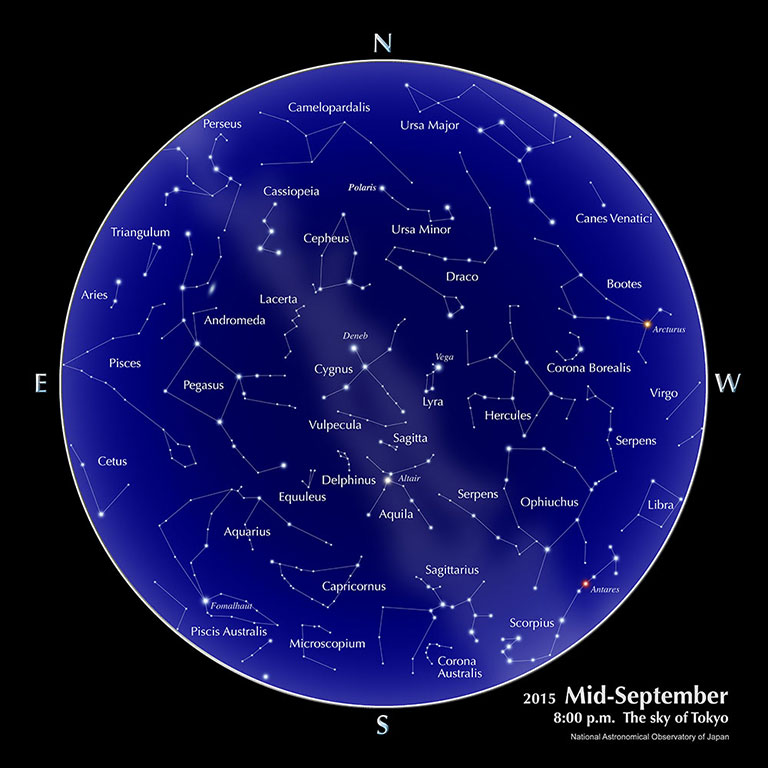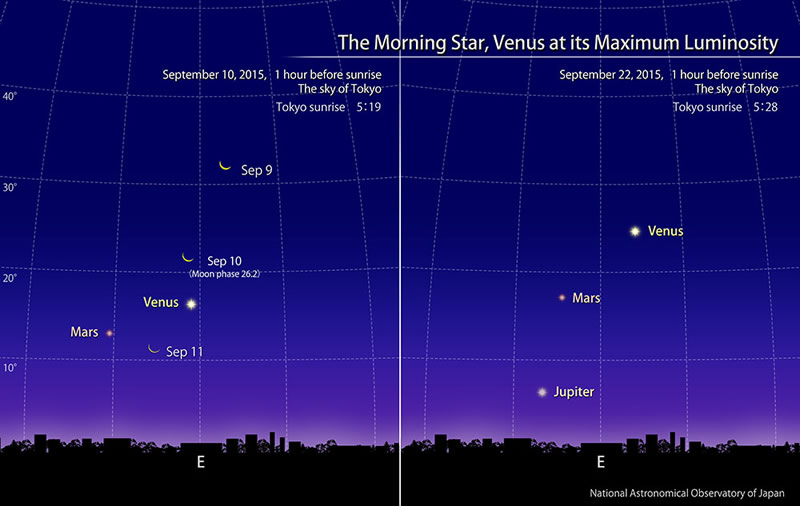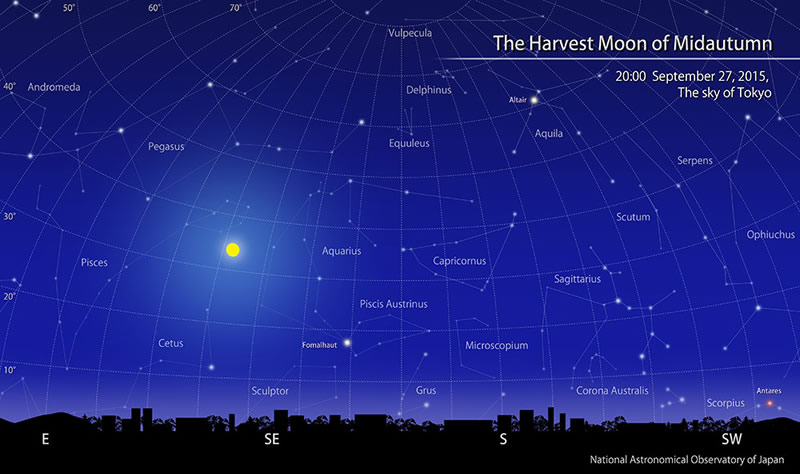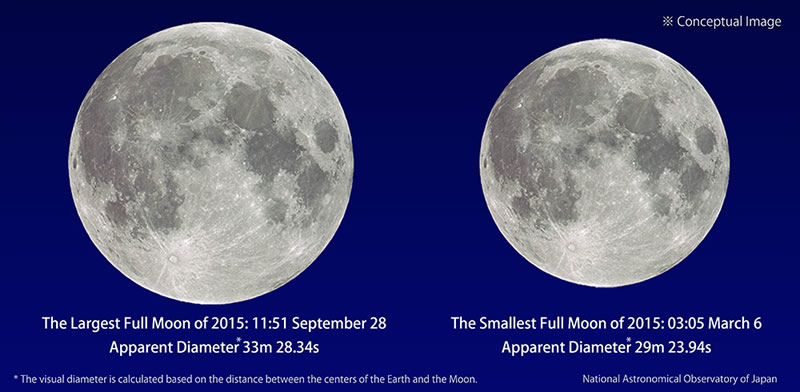September, 2015
Index
The sky of Tokyo

Calendar (September)
| 1 | Neptune at opposition |
| 4 | Greatest Eastern Elongation of Mercury |
| 5 | Last Quarter / Venus at stationary point |
| 13 | Solar eclipse (not able to observe in Japan) / New Moon |
| 17 | Mercury at stationary point |
| 21 | First Quarter / Keiro-no-hi [Respect-for-Senior-Citizens Day] (National holiday) |
| 22 | Venus is maximum magnitude of light (luminosity) / Holiday |
| 23 | Autumnal Equinox Day / Autumn equinox (Sun’s ecliptic longitude 180°) |
| 27 | The harvest moon |
| 28 | Total lunar eclipse (not able to observe in Japan) / Full Moon |
| 30 | Mercury at inferior conjunction |
Planets
- Mercury
- In the beginning of the month, Mercury is located low in the western sky immediately after sunset. It reaches its greatest eastern elongation on the 4th, but even at sunset its elevation is only 10 degrees, making observation difficult. In the beginning of the month, Mercury’s brightness is 0.2 magnitude to 0.4 magnitude.
- Venus
- Venus shines particularly bright in the eastern sky before sunrise. In the beginning of the month, the elevation is less than 10 degrees at an hour before sunrise, but towards the end of the month, the elevation increases. The brightness is -4.4 magnitude to -4.5 magnitude. On the 22nd, Venus reaches its maximum luminosity, -4.5 magnitude.
- Mars
- Mars moves from the constellation Cancer to the constellation Leo. Look low in the eastern sky before sunrise. The brightness is 1.8 magnitude.
- Jupiter
- Jupiter, located in the constellation Leo, can be seen low in the eastern sky before sunrise. The elevation rises in the last part of the month, making it easier to observe. The brightness is -1.7 magnitude.
- Suturn
- Saturn, located in the constellation Libra, can be seen in the southwestern sky after sunset. The brightness is 0.5 magnitude to 0.6 magnitude.
Source: Ephemeris Computation Office, NAOJ
With the “Sky Viewer” you can easily explore the appearance of a typical urban night sky (planets and constellations are visible).The Celestial Phenomenasection of the glossary explains the planetary phenomena terms: greatest elongation, opposition, conjunction, stationary, etc.
Topics
The Morning Star, Venus at its Maximum Luminosity

Venus, the Morning Star, stands out very well in the eastern sky before sunrise. Venus reaches its maximum luminosity on September 22. It continues to shine brightly until the middle of October, maintaining a luminosity of -4.5 magnitude.
On September 10, the thin Moon appears to approach Venus, making a beautiful spectacle. Mars can also be found close to Venus. In the last part of the month, the elevation of Jupiter increases. You can enjoy the dance of these 3 planets before sunrise.
The Harvest Moon of Midautumn

This year’s Harvest Moon is on September 27.
The “Harvest Moon of Midautumn” is the name given to the Moon on the night of the 15th day in the 8th month of the luni-solar calendar (*). Related to agricultural events, it is also called “Imomeigetsu” (the Potato Harvest Moon) in Japan. The custom of considering the Harvest Moon auspicious is said to have come to Japan from China during the Heian era.
This year’s Harvest Moon is September 27; the full moon is the next day, September 28, so the Harvest Moon and the Full Moon are separated by 1 day. The Harvest Moon is the Moon on the night 15 days after the new moon. The full moon indicates the moment when the Sun and Moon appear in opposite directions as viewed from the Earth. Because the methods for determining them are different, a difference can develop between their dates.
In addition, the night of the 13th day of the 9th month of the luni-solar calendar is known as the “13th Night.” In Japan it is traditional to go Moon Viewing on this evening. The 13th Night is also known as “Nochinotsuki” (The Future Moon), “Mamemeigetsu” (the Bean Harvest Moon) or “Kurimeigetsu” (The Chestnut Harvest Moon or Hunter’s Moon). This year, the 13th Night falls on October 25.
(*) The calendar used in Japan up through the Meiji era. The days of each month are determined based on the phase of the Moon.
The Largest Full Moon of the Year

The Moon of September 28 appears to be the largest full moon of the year.
The Moon is a celestial object which orbits the Earth. Because that orbit is elliptical, the distance between the Earth and the Moon is not fixed. Also, because the orbit of the Moon changes due to being affected by things like the Sun and the Earth, the distances at the times when the Moon is closest to the Earth (perigee) and farthest from the Earth (apogee) change each time.
This time, the Moon makes its closest approach to the Earth for this year (approximately 356,900 kilometers) at 10:46 on the morning of September 28. And approximately 1 hour later, at 11:51 it reaches the moment of full moon. However, in Japan this is a time when the Moon is below the horizon. At the moment of the full moon the apparent diameter is 33.5 arcminutes.
In contrast, the full moon which looks the smallest this year is March 6. On this day, the Moon passes apogee at 16:33 on March 5 and reaches the moment of full moon at 03:05 on March 6. At this time the apparent diameter of the Moon is 29.4 arcminutes. Using the chart below to compare the sizes, it can be understood that they are very different.